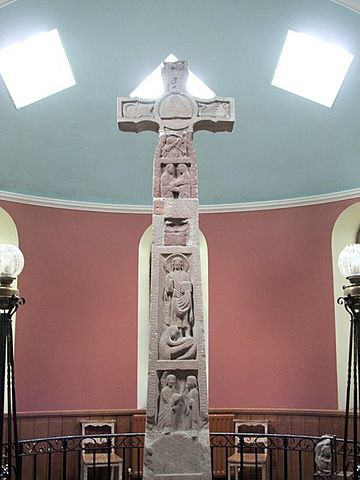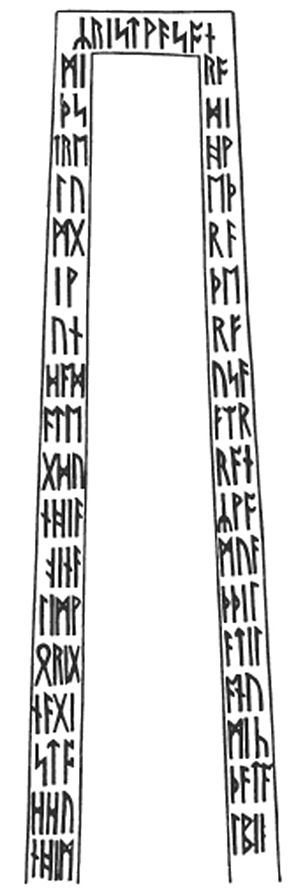Ruthwell Cross facts for kids
The Ruthwell Cross is a very old stone cross from the 8th century. It was made when the village of Ruthwell (now in Scotland) was part of a powerful Anglo-Saxon kingdom called Northumbria.
This cross is one of the most famous and detailed Anglo-Saxon stone carvings ever found. It might even have the oldest surviving English writing, older than any books with Old English poems. A famous expert, Nikolaus Pevsner, said that the Ruthwell Cross and the Bewcastle Cross are "the greatest achievement of their date in the whole of Europe."
Sadly, the cross was broken into pieces in 1642 by Presbyterian groups who did not like religious statues. The pieces were left in the churchyard for many years. In 1823, a man named Henry Duncan collected the pieces and put them back together in his garden. In 1887, the cross was moved to its current home inside Ruthwell church in Dumfriesshire, Scotland. A special room was built just for it.
Contents
What the Ruthwell Cross Looks Like
Anglo-Saxon crosses are similar to the tall high crosses found in Ireland. Both are part of a style called Insular art. The Ruthwell Cross has the largest carved pictures (called reliefs) found on any Anglo-Saxon cross. These carvings are also some of the biggest Anglo-Saxon carvings still existing.
The cross has writing in two languages: Latin and the runic alphabet. It's unusual to find runes on a Christian monument. Some of the runic writing is similar to parts of an old English poem called Dream of the Rood. The cross stands about 5.5 meters (18 feet) tall.
The two main sides of the cross (north and south) have carved pictures of Christ and other people. These carvings are quite worn now. Experts have studied what these pictures mean for a long time. Many believe the pictures and words work together to tell a complex story.
North Side Carvings
The biggest picture on the north side shows either Christ treading on the beasts or Christ as Judge recognised by the beasts in the desert. This scene was very popular with the Anglo-Saxons. A Latin message around the picture says: "Jesus Christ: the judge of righteousness: the beasts and dragons recognised in the desert the saviour of the world."
Below this, you can see Saints Paul and Antony breaking bread in the desert. Another Latin message helps us know who they are. Below that is a scene that might be the Flight into Egypt or a Return from Egypt. The very bottom picture is too worn to tell what it is, but it might have been a Nativity of Christ.
South Side Carvings
On the south side, there's a picture of Mary Magdalene drying the feet of Christ. A long Latin message describes this scene from the Bible. Below this, you can see the Healing of the man born blind.
Further down are the Annunciation (when an angel tells Mary she will have Jesus) and the Crucifixion. The crucifixion scene might have been added much later than the rest of the cross.
Above the main pictures on the north side, there's a figure that could be John the Baptist or God the Father holding the Lamb of God. Higher up, there are two figures from the Four Evangelists (the writers of the Gospels): St. Matthew and St. John the Evangelist. The arms and center of the cross-head are new parts that were added during a repair.
On the south side, above the main pictures, are Martha and Mary. Then there's a picture of an archer, which experts still debate about. An eagle is carved on the top arm.
How the Cross Was Broken and Fixed
The Ruthwell Cross was not damaged during the Scottish Reformation in the 1500s. However, in 1640, the General Assembly of the Church of Scotland ordered that "many idolatrous monuments" (religious statues they didn't approve of) should be "taken down, demolished, and destroyed."
Two years later, in 1642, the cross was finally taken down and broken. People say one piece was even used as a bench! The broken pieces were left outside in the churchyard.
In 1823, Henry Duncan gathered all the pieces he could find. He had a new crossbeam made because the original was lost. He also filled in gaps with small stones. Then, he put the cross back together in his garden. Some people question if his repair was exactly right, as he based it on drawings of other "Popish" (Roman Catholic) items.
Is it a Cross or a Pillar?
Some experts have wondered if the Ruthwell Cross was always meant to be a cross. In 2008, a scholar named Patrick W. Conner suggested it might not have been a cross originally. He prefers to call it the "Ruthwell Monument."
Another scholar, Fred Orton, believes the bottom part of the monument might never have been part of a standing cross. He also thinks the monument is made of two different types of stone. He suggests it might have started as a column, then had a crucifixion scene added, and later a cross made of a different stone was attached.
Runic Writing on the Cross
Along the sides of the vine carvings, there are inscriptions in runes. These runes were first described around 1600. Around 1832, a scholar named Thorleif Repp realized these runes were different from Scandinavian runes. They were Anglo-Saxon runes.
Later, in 1840, John Mitchell Kemble suggested a reading that mentioned Mary Magdalene. In 1842, Kemble offered a new reading that connected the runes to the poem Dream of the Rood.
Here's what the inscription along the top and left side is read as:
- Krist wæs on rodi. Hweþræ / þer fusæ fearran kwomu / æþþilæ til anum / ic þæt al bih[eald].
- "Christ was on the cross. And there hastening from far came they to the noble prince. I beheld all that."
The inscription on the left side is read:
- Mith strelum giwundad alegdun hiæ hinæ limwoerignæ gistoddun him
- "With missiles wounded, they laid him down limb-weary, they stood by him"
Many experts believe that the runic inscriptions were added later than the Latin ones, possibly as late as the 10th century. This means the cross might have been standing for a while before the runic poem was carved onto it.
Recent Studies
The "Visionary Cross project" is a group of researchers who study crosses like the Ruthwell Cross, the Bewcastle Cross, and the Brussels Cross. In 2012, they used 3D-scans to study the Ruthwell Cross in detail.
Gallery
See also
 In Spanish: Cruz de Ruthwell para niños
In Spanish: Cruz de Ruthwell para niños












